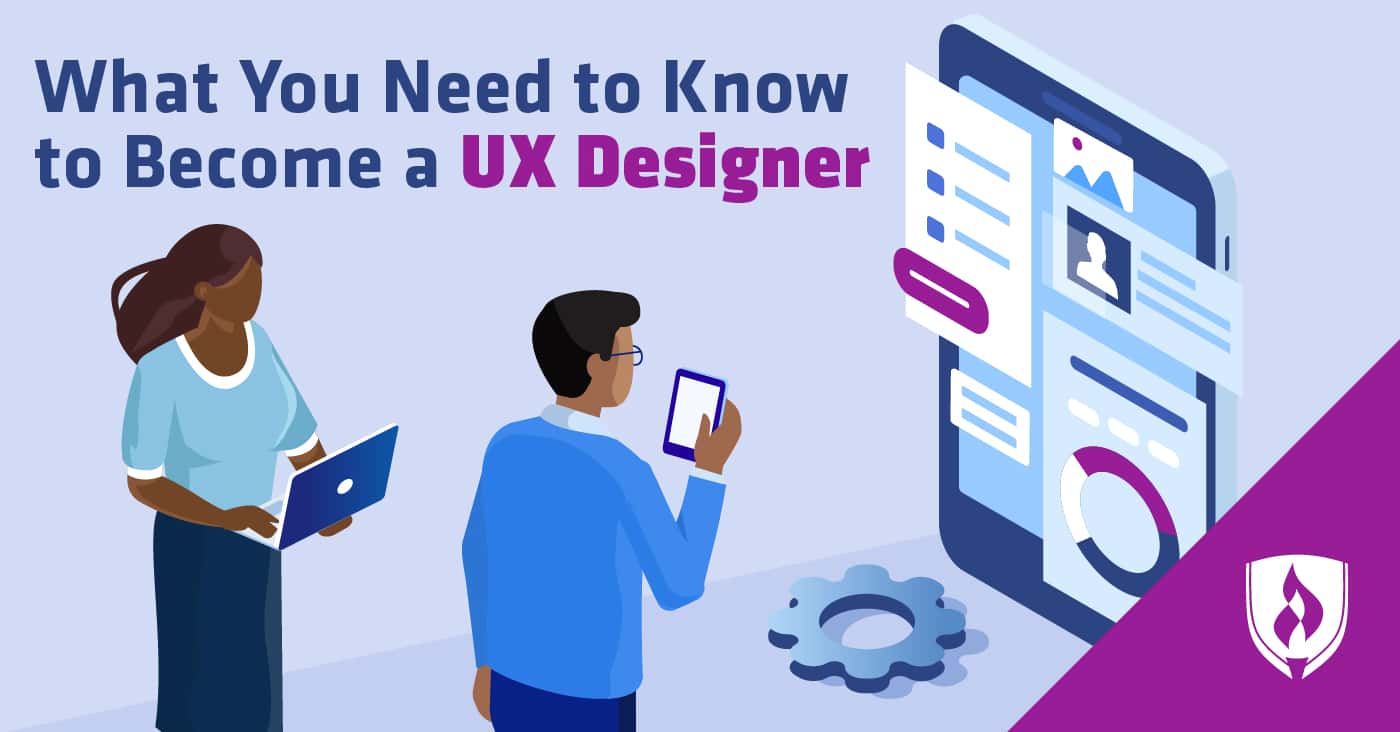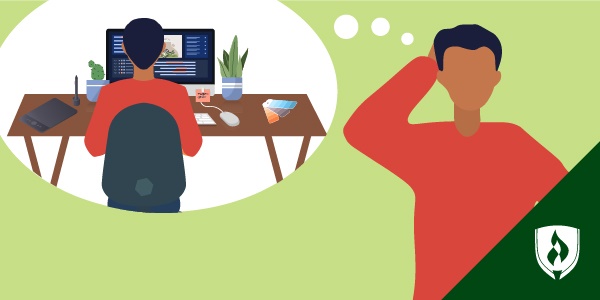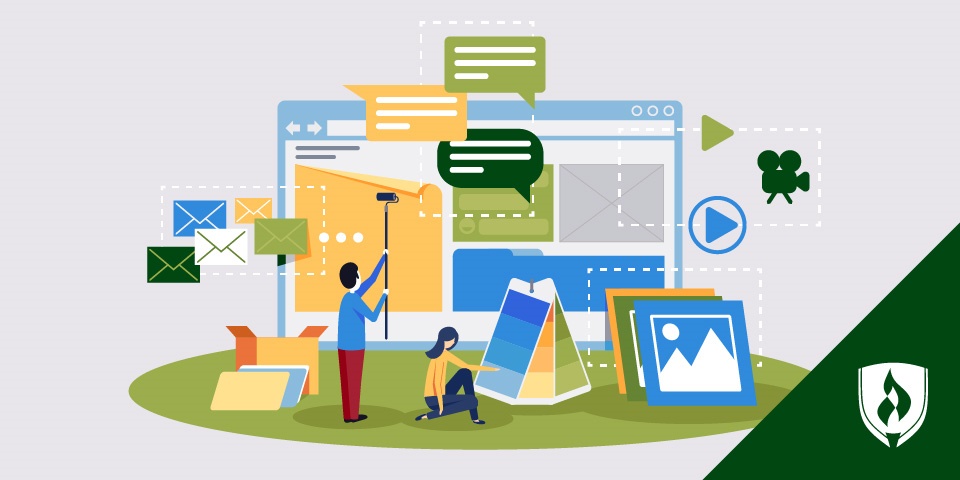
If you’ve spent any time searching for a design job, the odds are good you’ve seen a job posting looking for a user experience (UX) designer. You have the vague sense that UX design has something to do with websites. But you still have plenty to learn about this growing portion of the design field—and the UX design careers you keep seeing so much about.
What exactly do these creative professionals do? How do you become a UX designer? We enlisted the help of experienced design pros to take a closer look at how to define UX design and what it takes to launch a career in this evolving field.
Join us as we learn from the experts about everything from the importance of user experience to the UX design skills you’ll need in the workforce.
What is user experience?
The term user experience refers to the way people interact with a designed product, from apps and websites to physical products. “User experience is focused on designing digital and physical products that are intuitive to use and which meet a user's needs in sensible, efficient and pleasant ways,” says senior UX designer Kat Vellos.
UX design is like air: you may not notice it most of the time, but it becomes painfully obvious when it’s not there. “If you've ever screamed at your phone or a computer because a website or app confused or frustrated you, then you know what a bad UX design feels like,” Vellos says.
Having user-friendly design is about more than just convenience, however. Jesse Crouch, owner of Never Astray, points out that “if you can't use the tools available because they're too confusing, then you probably won't use them at all.”
Why is UX design important?
This brings us to the importance of UX design. If digital content is so poorly designed that users simply avoid it, they could be missing out on information or resources they need. “UX design is important to making sure that all people are able to understand and easily use the products, services and interfaces they need to interact with,” Vellos says.
The impact of UX design extends beyond individual users, however. User experience is so vital to the digital world that it’s driven the development of new products and design trends, including groundbreaking technology like smart phones.
“The trends of the web itself have shaped themselves around user experience,” Crouch says. “Responsive design, high-performance web pages and a heavy focus on design-oriented technologies like the advancement of CSS standards are what make the web beautiful and enjoyable to use today.”
What do UX designers do?
UX designers are tasked with overseeing the entire process of designing a new website, app or product. According to the Interaction Design Foundation, UX designers need to ask themselves why, what and how consumers will use a product. Only after answering these questions will they be ready to create a strong, intuitive user experience.
To the untrained eye, the daily tasks of a UX designer may look similar to any other type of web or graphic design. These professionals use the same software and tools, such as the Adobe Creative Suite®, to create designs that meet clients’ expectations and communicate a message. But beneath the surface, they’re always evaluating how their design choices will impact the usability of the final product.
UX designers conduct extensive user research, including interviews, to understand end users’ motivations for using a product and how they expect it to function. They also create prototypes and wireframes to plan their designs, and they work closely with clients and other members of the design team to ensure that the project meets its goals and stays on budget.
Where do UX designers work?
UX designers have a similar work environment as graphic designers and web developers. Many graphic designers are employed by specialized design firms or agencies that work with clients who don’t have their own staff of dedicated designers, according to the Bureau of Labor Statistics (BLS).1
However, the majority of UX designers are self-employed and work with clients directly, with the BLS reporting that 22 percent of graphic designers and 16 percent of web developers are independent contractors.1 UX designers who work as freelancers can typically enjoy a flexible work schedule, although they must also spend time marketing their business to attract new clients.
What UX design skills are needed?
It takes a special skillset to be able to work as a UX designer! These professionals need creativity, an understanding of basic design principles and the ability to know exactly how a user will work with the finished product.
“Empathy will help you focus on the user's needs and priorities at all times during the design process,” Vellos says.
Soft skills like these give UX designers the understanding they need to deliver a top-notch user experience. We analyzed more than 23,000 UX designer job postings to uncover this list of top transferable skills in this design career:
Transferable skills in demand2
- Creativity
- Collaboration
- Research
- Communication
- Problem solving
- Attention to detail
- Presentation skills
- Writing
- Planning
- Time management
Of course, even with these transferable skills under their belts, UX designers still need to be well versed in the latest technology and tools of the trade. These are the top technical skills employers are looking for in UX designers:
Technical skills in demand2
- UX wireframes
- Prototyping
- User research
- Adobe Creative Suite
- Interaction design
- User interface design
- Information architecture
- Usability testing
- Process design
- JavaScript
How do you become a UX designer?
If a career in UX design is on your radar, earning a bachelor’s degree in graphic design is a strong first step. Although there are many bootcamp-style programs available to give students a crash course in UX design, our analysis of more than 13,000 UX designer job postings revealed that 92 percent of employers are seeking candidates with a bachelor’s degree.3
This education shows employers at a glance that you have a solid foundation in the basic principles of design. You can also gain real-world experience in UX by landing a related internship or assigning yourself your own UX design projects to build up your portfolio for prospective employers.
There are also several professional certificates available, such as the UX Certification from Nielsen Norman Group. Design professionals are typically eligible for certification after attaining a certain number of experience hours and passing an exam. Although these certifications are optional, they offer another way to show employers that you have the unique skillset UX design requires.
Are you cut out for UX design?
You finally have answers to all your burning questions about UX design careers. But there’s still more to learn before you become a UX designer! Stay on top of the latest UX design principles with these 8 Basic User Experience Guidelines Designers Need to Know.
1Bureau of Labor Statistics, U.S. Department of Labor, Occupational Outlook Handbook, [accessed April, 2020] www.bls.gov/ooh/. Information represents national, averaged data for the occupations listed and includes workers at all levels of education and experience. This data does not represent starting salaries. Employment conditions in your area may vary.
2Burning-Glass.com (analysis of 23,563 UX designer job postings, March. 01, 2019–February 29, 2020.)
3Burning-Glass.com (analysis of 13,027 UX designer job postings by education level, March. 01, 2019–February 29, 2020.)
EDITOR’S NOTE: This article was originally published in 2016. It has since been updated to include information relevant to 2020.
Adobe Creative Suite is a registered trademark of Adobe Software, Inc.
JavaScript is a registered trademark of Oracle, Inc.




